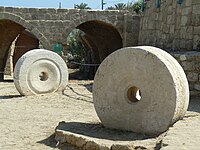| Revision as of 11:43, 19 July 2010 editBD2412 (talk | contribs)Autopatrolled, IP block exemptions, Administrators2,453,458 editsm →History: Fixing links to disambiguation pages, improving links, other minor cleanup tasks, replaced: Genesis → Genesis using AWB← Previous edit | Revision as of 18:42, 5 August 2010 edit undoLilHelpa (talk | contribs)Extended confirmed users, Pending changes reviewers413,652 editsm fixing "the the"Next edit → | ||
| Line 11: | Line 11: | ||
| Remnants of ancient Achziv, now known as Tel Achziv, are located on a sandstone mound between two creeks, Kziv creek on the north and Shaal creek on the south, close to the border with Lebanon. | Remnants of ancient Achziv, now known as Tel Achziv, are located on a sandstone mound between two creeks, Kziv creek on the north and Shaal creek on the south, close to the border with Lebanon. | ||
| The Arab village of ] was established during the Mamluk and Ottoman periods, the houses erected using the stones of the Crusader castle. The villagers fled to Lebanon during the ]. In 1946, |
The Arab village of ] was established during the Mamluk and Ottoman periods, the houses erected using the stones of the Crusader castle. The villagers fled to Lebanon during the ]. In 1946, ] blew up the railroad bridge over the creek at Achziv in an operation known as ]. A monument to the 14 soldiers killed there was erected on the site. | ||
| ==Archaeology== | ==Archaeology== | ||
Revision as of 18:42, 5 August 2010

Achziv is an archaeological site on the northern coast of Israel, 15 kilometers north of Acre. It was first settled in the Middle Canaanite (Bronze) II period by the Phoenicians. In the Bible, it is described as falling within territory assigned to the tribe of Asher. An Arab village, Az-Zeeb, was established on the site during the Mamluk period. Today Achziv is a national park.
History

In the Bible, Achziv was a town in the Shephelah, or plain country of Judah (Josh. 15:44); probably the same as Chezibh mentioned in Genesis38:5. Originally a Phoenician city (Ecdippa in Greek), it was assigned to the tribe of Asher (Josh. 19:29; Judg. 1:31) "And the fifth lot came out for the tribe of the children of Asher ... and the outgoings thereof are at the sea from the coast to Achzibh." Achziv (Cheziv) is mentioned in Jewish rabbinic writings, for example Midrash Vayikra Rabba 37:4. King David added the city into his Kingdom, but King Solomon returned it to Hiram as part of the famous pact. During Sancheriv invasions, the Assyrians conquered the city. During the reign of the Seleucids, the border was established at Rosh HaNikra, just north to Achziv, making it a border city and under the control of Acre. A maritime city named Cziv, nine miles north of Acre, is mentioned by Josephus Flavius, and later by Eusebius. During the Crusader period, the site was known as Casle Umberti.
Remnants of ancient Achziv, now known as Tel Achziv, are located on a sandstone mound between two creeks, Kziv creek on the north and Shaal creek on the south, close to the border with Lebanon.
The Arab village of Az-Zeeb was established during the Mamluk and Ottoman periods, the houses erected using the stones of the Crusader castle. The villagers fled to Lebanon during the 1948 Arab–Israeli War. In 1946, The Jewish Resistance Movement blew up the railroad bridge over the creek at Achziv in an operation known as Night of the Bridges. A monument to the 14 soldiers killed there was erected on the site.
Archaeology

An ancient port was located on the coast, and another secondary port is located 700 m to the south. Archeological excavations have revealed that a walled city existed at the location from the Middle Bronze period. History of Achziv goes back to the Chalcolithic period (45-32C BC).
References
33°03′N 35°06′E / 33.050°N 35.100°E / 33.050; 35.100
Categories: